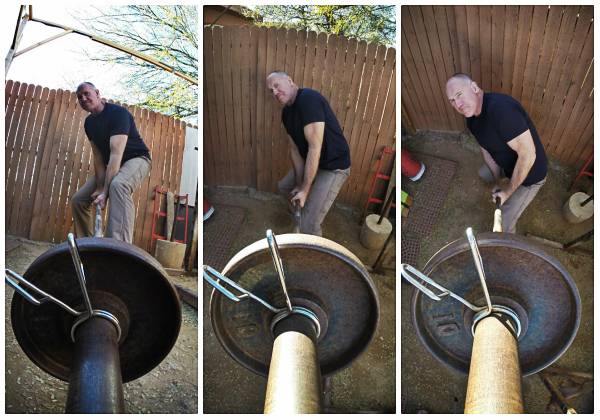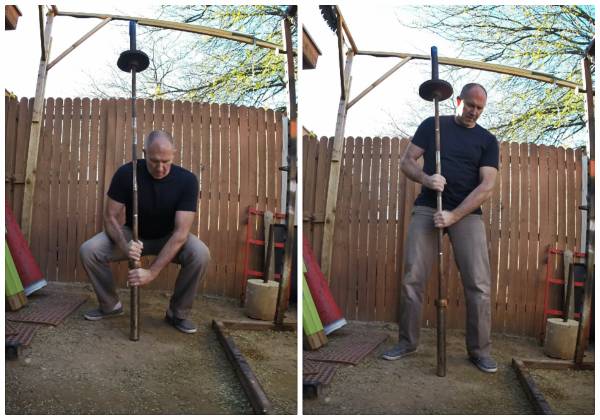For a number of years, when I lived in an apartment in Arizona, I trained with a barbell and some weight plates out in the desert. I’d fit the barbell and plates into my vehicle any way I could. Training with a large variety of implements has always been my forte, but it doesn’t mean I can’t hang with a barbell.
For a number of years, when I lived in an apartment in Arizona, I trained with a barbell and some weight plates out in the desert. I’d fit the barbell and plates into my vehicle any way I could. Training with a large variety of implements has always been my forte, but it doesn’t mean I can’t hang with a barbell.
The problem with only training with a barbell is that it’s easy to get stuck in a rut. That’s okay if you are into Olympic weightlifting (the true power sport) or powerlifting (the true strength sport). You’ve got to focus on what you will compete in if you are going to compete in it.
But that has never been me. I’ve always preferred some diversity with my constancy. So I’d take my metal pole and plates, head out to the desert, and find a flat spot to train. No rack, no bench, no spotters, no fans, no mirrors, and no music.
It was just me and the metal, enduring dry-dusty-wind coupled with convection-oven-strength sunshine. Sometimes a coyote or two would meander by, or perhaps some javelina. I always had a good-sized water jug and perhaps some watered-down Gatorade with me. Gatorade was just too sweet, so I’d cut it with water so I wouldn’t consume so much sugar. Boom, baby! You’ve got G2. I like to think I invented it.
So there I was, doing my thing with the metal. What would you do?
When it’s just you, a barbell, and the desert sun, you get creative.
The Sonoran Routine
Most people would probably deadlift. Not too much thought to figure that one out. Many would probably do some rows, curls, or maybe some overhead presses. I did all that on some days.
Often I would do something more like this:
- Hang power clean and press 3×3
- Power clean and push press 3×3
- Clean and jerk 3×1-3 reps
- A few sets of overhead squats
On a different day:
- Hang snatch 3×5
- Power snatch, lower to shoulders and then drop snatch 3×3
- Snatch 3-5×1-3 reps
- Several sets of front squats
Sprinkle In Some Diversity
Keep in mind, I wasn’t training to compete in a weightlifting contest. I was training because I loved it and wanted to get stronger, faster, and tougher. I wanted athletic ability. And to develop that, you need two things I mentioned earlier: constancy and diversity. Constancy is measurable, programmable, and easily tested. You know right where you are at all times. It’s a must for making progressive gains in gym performance.
But the outside world is different. Sports are different. You face diversity all the time – or at least, I hope you do, otherwise life gets pretty boring. This is where adding some diversity in your training comes in. A little sprinkled here and there can open up worlds of ability and competence.
Thus, the articles on bear-hug squats, one shoulder squats, impact training, and other fun little things. These are forms of diversification in your training. You are forced to adapt and overcome in order to perform. Each little bit of diversity gives you something in return. Rotating these around adds to your ability to adapt. Diversification keeps the brain-body connection engaged.
Trade Your Shovel for a Fishin’ Pole
So let’s go back to the desert. Naturally, me being me, I started to get creative. Now, if I showed you everything I did, you might go off and try it all yourself, then end up such a huge hurtin’ unit you might swear off lifting ever again. So with that in mind, I’ll give you one thing I played around with at that time. Some might call it a shovel lift. With a shovel lift people try to imitate lifting a shovel full of dirt and do all sorts of odd movements, twisting and rotating. Also, with the shovel lift people choke way up the handle near the weight. Why? Because it’s easier to lift as you have better leverage.
The lift I’m going to show you is a bit different, so I call it “fishin’ pole and carry.” You will be lifting nearly straight up with very poor leverage. I doubt you know anyone who can do this with a 45lb plate. So, start with just a bar to get used to it. I purposely limited myself to 10lb for the pics. I didn’t want to influence anyone into trying too much too soon. These are brutal. You’ll soon find out why.
The 4-Week Fishin’ Pole and Carry Challenge

Go somewhere by yourself. You don’t want to have to explain what you’re doing to the gym-bros.
So, here’s this month’s challenge:
- Go somewhere so no one will see you. First off, you don’t want to have to explain what you are doing. Secondly, you will probably be embarrassed about how little weight, if any, you can handle. This is okay, since it’s not about the weight. It’s about how you use your body and leverage your strength.
- Grab a bar. Get on one end in a staggered stance and with your left hand grab the bar right up near the inside of the collar. Place the right hand right on the end of the bar. You will not change hand positions. Keep your hands welded right where I have them in the picture. You can change hand position once you get vertical only if you are going to do a vertical carry.
- Lift the end up that you are grabbing and keep your right arm near your groin. Now brace yourself and press down with the right arm as you lift with the left arm. It’s like a giant fishing pole. You are pushing and pulling and leaning at the same time. Keep your arms straight until you get the bar a ways above the horizontal.
- Keep pressing and pulling and lift that bar to the point where the weight transfers back into your body and it’s fairly easy to hold there. Lower the bar carefully back to the ground, reset yourself, brace and press/pull it up again. Perform 3-5 reps. This is not a high-rep movement. A little goes a long way.
- On the last rep, pull the bar up to vertical and let it lay back against your shoulder area. Adjust your grip and hand spacing and take the bar for a walk of 60 feet or so.
- Set the bar down, but remember – if you try to tilt the bar back down from vertical and set it on the ground, you will find it very difficult. I don’t recommend that. Instead, simply lower the end in your hands straight down to the ground. Squat down to put the vertical bar down gently or you can let the bar slide down through your hands until the end hits the dirt. From there simply walk the bar back down to the ground.
- Now switch everything around and work the other side. Keep working back and forth on each side including the carries, resting as you feel the need. When you’re able to work for about ten minutes with that weight, add a small amount to the opposite end of the bar for the next session. You can simply do 3-5 sets each side if you want.

Once the bar is against your shoulder, you can squat it to the ground (left) or let it slide through your hands (right).
You can also eliminate the carries and just work on the lifts. However, doing the carries in this position with the light weight is a nice recovery effort that hits the body a bit different. Practicing this lift 2-3 times per week is plenty.
Take your time before adding any weight to the end of the bar, and only jump up by a kilogram (2.2lb) or 2.5lb per weight increase. Be sure to get real tight and brace yourself to receive the leverage this will apply to your body. It is totally unlike most lifts you will ever do. Don’t attempt to see how much you can lift or you might pull something. Really, if you push too hard too soon this lift can tear you up. Get tight and stay tight throughout this lift.
Stay focused, and control the lift from start to finish. Don’t relax until you have set the bar back on the ground and are standing fully upright. Gradually build up your leveraging strength and give your body and tendons time to adapt to this strange lift or it will bite you. Remember, “Festina lente”—“Make haste slowly.”
Torque, Leverage, and Unexpected Strength
This lift has teeth, so be careful. It will hammer you and teach you that the body has many ways of using its strength and leverage. Your body will be dealing with torque from various angles. It will develop that odd-ball strength many laborers and multi-sport players have, what I like to call “unexpected strength.”
So there you go. Have at it and let me know what you think. If constancy is the progression, diversity is the application. Improvise, adapt, overcome. Unexpected strength is coming at you!
More Unusual Protocols for Unexpected Strength:






